|
Miklos
Pogany
14
November ~ 12 December,
2004
KANTAR
FINE ARTS presents the artist and master printmaker, MIKLOS
POGANY, in a retrospective exhibition of his unique collage
monotypes. Mixed Media showcases a selection and evolution
of his work over the past twenty years.
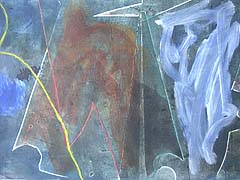
|
Detail: Une Jour de Marriage |
Miklos Pogany, whose grandmother was the Mlle. Pogany who inspired the
famous Brancusi sculpture of that name, was hailed as “an artist
of great sensitivity...(and) also a fine colorist,” by Willem de
Looper, the former Curator of The Phillips Collection, at the time of
Pogany’s solo show there, in 1985. A self-taught artist, Pogany
has continually stretched the limits of each printing technique he explored,
particularly monotype, realizing wonderfully complex surfaces, by using
a unique technique, which he developed, with different papers (including
supermarket shopping bags!) and other materials for his plate, and overlaying
the surface with layers of ink, oil colors, pastels, crayons, chalks,
and oil stick. His abstractions and more representational works emanate
a mysterious, emotional quality, and suggest a moment in the passage
of time, a moment of being that could transform itself at the next glance.
Colors, textures, lines and shapes are subtly connected and interdependent.
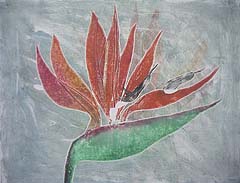
|
Bird of Paradise |
Pogany has had many solo exhibitions, including a major show at The Phillips
Collection, Washington, D.C., at Associated American Artists, New York,
the Paul Mellon Art Center, Wallingford, CT, Miklos Pogany, “Artist’s
Showcase”, sponsored by The Connecticut Commision on the Arts,
Hartford, CT, at the Mattatuck Museum, Waterbury, CT, and at Impressions
Gallery (NY and Boston), and Victoria Munroe Gallery (New York). His
work is in many prestigious public collections, including the Victoria
and Albert Museum, London, England, and, nationally, The Phillips Collection,
Washington, D.C., The Metropolitan Museum of Art, New York, the National
Museum of American Art, Smithsonian Institution, New York Public Library,
Yale University Art Gallery, the Philadelphia Museum of Art, the Christian
Science Center, Boston, The Lois and Michael Torf Collection, Boston,
MA, and the Achenbach Foundation for the Graphic Arts in San Francisco.
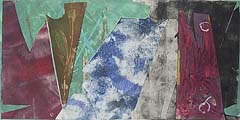
|
Une Jour de Marriage |
He is also represented in the collection of global corporations, including
AT&T, The Bank of America, Biogen, Chemical Bank, Mobil Corporation,
and Solomon Brothers.
Miklos Pogany was born in Budapest, Hungary, in 1945,
educated in Italy and the United States, receiving
an MA and PhD from the University of Chicago. In
1972, after being a Professor of Humanities and Comparative
Literature for several years, he decided to become an artist. He is
self-taught. He is currently on the Faculty of
the Art Department at Buckingham, Browne & Nichols Schools,
in Cambridge, MA.
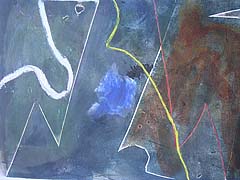
|
Detail: Une Jour de Marriage (2) |
“One of the strongest traditions in contemporary American art is exemplified
by the self-taught artist. In Pogany’s case, the application of self-taught,
often innovative technique in monotype, their influence on his work in other
mediums, has been strongly affected by the artist’s thorough grounding
in literature and philosophy. In fact, what distinguishes his abstractions from
those of his contemporaries is their metaphysical content.
|
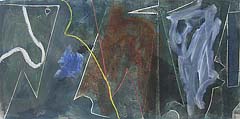
|
Une Jour de Marriage (2) |
|

|
Une Jour de Marriage |
|
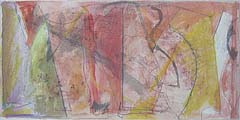
|
Une Jour de Marriage |
|
Isolated
against an abstract ground, Pogany’s highly evolved
form seems to exist in the timeless moment before or after
some indescribable event. His ability to induce an air of
mystery in his work not only sets him apart from most abstract
artists...the almost supernatural feeling of wonder his paintings
and monotypes embody is the direct result of a carefully
orchestrated interaction between technique and image, process
and form.
Pogany
has continually tested the limits of each medium he explored, particularly
monotype. Since he treats his monotypes as paintings, not prints,
he feels free to rework them with any material he chooses. It is
not unusual for him to go back into a monotype with gesso, wax,
oil paint, watercolor, or collage.” John Lau, Miklos
Pogany: Paintings and Works on Paper, The Phillips Collection,
Washington, D.C., March 30 – May 26, 1985
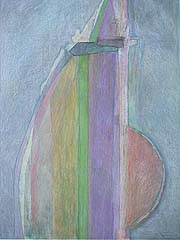
|
Study for Large Female Monument (3) |
|
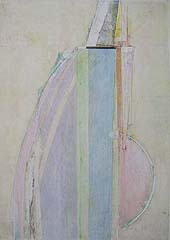
|
Desert Stillness Hiding Its Delight |
|
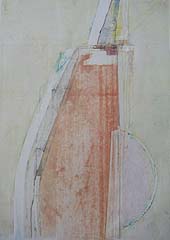
|
Klarika, 1988 |
|
| In
discussing the Klarika series, John Lau notes, “It
is with this series that Pogany emerged as a major abstract artist. Typically,
a scaffold of lines is used to locate the form in profile against
a crefully worked, evocative ground. Counterpointing the form’s
severity, its diagnonal thrust, is
a moon-like shape pushing out from each side. The lines and interlocking
shapes have been tightly orchestrated, so that the viewer almost
immediately perceives the stalemate between the image’s
vertical placement and its diagonal thrust. Consequently,
there is both an extreme stillness and a hint of movement, as
if the figural presence is floating across our perceptual field.
The essence of Klarika’s abstract form is harsh, standoffish,
angular, sensual, sturdy, and ghostly. It is physical and ethereal,
palpable and elusive. In
its combination of attenuated triangles, rectangles, lines, scimitar-like
arcs, the abstract form has affinities with the geometric compositions
of both Piero della Francesca and the Russian Constructivists...” |

|
LíAnnunziata |
|

|
Anika |
|
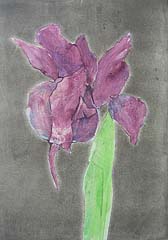
|
Iris |
|
“Color
is used to evoke a season and
a place, or a specific kind of light....” - John Lau,
The Phillips Collection, Washington, D.C., 1985
Richard S.
Field, former Curator, Yale University Art Gallery, in an essay
for Pogany’s catalogue for his Associated American Artists
exhibit, December 1989, extolled Pogany’s work, calling
it “a rich and monumental series of prints.”
“Pogany’s
monotypes, though suffused with the compression of printing,
and unfailingly responsive to the beautiful papers on which
they are printed, appear very much like painted low reliefs;
and the etchings, though composed of line and texture, only
spring to life when endowed with the mysterious space of Pogany’s
color, applied
both before and after printing.” Richard S. Field, AAA
catalogue, 1989
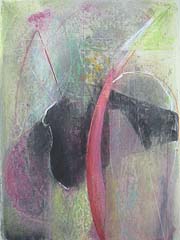
|
Wings of the Gifted Child |

|
The Very Thought of You |
|
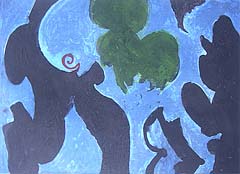
|
The Very Thought of You (2) |
|
In
recent years, other natural forms, including the human form,
have entered Pogany’s artistic language using the vitrograph
process, or sandblasting several glass plates, infusing them
with color, then printing.

|
The Place where the words come from |
Editions
of 20 or 30 were possible, with
each print often enhanced by the artist with pastel or printer’s
ink, making
for a ‘variant edition.’
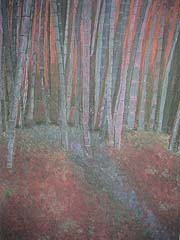
|
Lost Manís River |
|
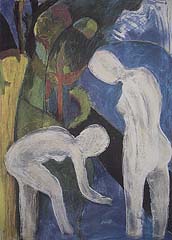
|
Fontis Ninphae |
|
|
|



















